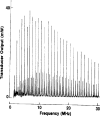An Ultrasonic Absolute Power Transfer Standard - PubMed (original) (raw)
An Ultrasonic Absolute Power Transfer Standard
Steven E Pick et al. J Res Natl Bur Stand (1977). 1984 Mar-Apr.
Abstract
In response to increased interest in the use of calibrated sources of ultrasonic energy, we have developed a system comprising components grouped to facilitate the accurate transfer of calibration. Electronic circuitry supplied with and built into each ultrasonic transducer obviates both the use of not-readily-available radio-frequency equipment and the measurement of anything more exotic than dc voltage. Prototype transducers have shown good output at frequenices up to 78 MHz. Units now available to the public can be calibrated at output powers ranging from 5 mW to 500 mW at frequencies between 1 and 20 MHz.
Keywords: transfer calibrations; ultrasonic power standards; ultrasonic transducers.
Figures
Figure 1–
Interconnection of system components.
Figure 2–
Longitudinal section of standard ultrasonic source.
Figure 3–
Swept-frequency response of 0.5 MHz prototype transducer.
References
- Zapf T. Calibration of quartz transducers as ultrasonic power standards by an electrical method. Proc. 1974 Ultrasonics Symposium, 45–50, IEEE Cat. No. 74 CHO 896–1SU.
- Zapf T. L.; Harvey M. E., Larsen N. T., Staltenberg R, E.. Ultrasonic calorimeter for beam power measurements, Natl. Bur. Stand. (U.S.) Tech. Note 686 (1976).
- Greenspan M.; Breckenridge F. R., Tschiegg C. E.. Ultrasonic transducer power output by modulated radiation pressure (with details), Natl. Bur. Stand. (U.S.) NBSIR 78–1520(1978); also JASA V63 No. 4, April 1978.
LinkOut - more resources
Full Text Sources


